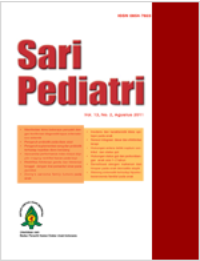Faktor Risiko Hiperkoagulasi pada Thalassemia Anak
Sari
Latar belakang. Hiperkoagulasi merupakan salah satu komplikasi thalassemia yang telah terjadi sebelum
manifestasi klinis ditemukan pada thalassemia anak. Sampai saat ini belum pernah ada penelitian khusus
mengenai faktor risiko hiperkoagulasi pada thalassemia anak.
Tujuan. Menentukan faktor risiko hiperkoagulasi pada thalassemia anak.
Metode. Desain penelitian potong lintang dilakukan sejak bulan Maret hingga April 2014 terhadap 87 subjek
di Poliklinik Thalassemia Anak RSHS Bandung. Hiperkoagulasi diketahui berdasarkan tromboelastografi
(TEG), apabila ditemukan minimal 2 dari 4 parameter terpenuhi dengan atau tanpa nilai CI lebih dari 3.
Analisis statistik faktor risiko dengan uji chi-square/Fisher dan regresi logistik.
Hasil. Prevalensi hiperkoagulasi thalassemia anak di RSHS Bandung 70% (61 subjek). Usia termuda
hiperkoagulasi positif adalah 5 tahun. Faktor risiko hiperkoagulasi thalassemia anak yang bermakna adalah
peningkatan jumlah trombosit (p=0,002; RP1,08; IK95%:1,003−1,013), sedangkan variabel lainnya
tidak berhubungan. Pasien pascasplenektomi sejumlah 9 subjek dengan kadar trombosit >500.000 mm3.
Hiperkoagulasi positif dapat memiliki jumlah trombosit yang meningkat dan/atau gangguan fungsi trombosit
berdasarkan TEG.
Kesimpulan. Peningkatan jumlah trombosit merupakan faktor risiko hiperkoagulasi thalassemia anak di
RSHS Bandung
Kata Kunci
Teks Lengkap:
PDFReferensi
Eldor A, Durst R, Hy-Am E. A chronic hypercoagulable
state in patients with beta-thalassemia major is
already present in childhood. Br J Haematol 1999;
:739−46.
Kemahli S, Gurman C, Egin Y. Hypercoagulability
in Children with Thalassemia Major. Clin Appl
Thrombosis1997;3:129−32.
Lismayanti L. Prevalensi hiperkoagulabilitas dan
gambaran serta hubungan antara hasil pemeriksaan
tromboelastografi dengan D-dimer pada anak yang
menderita thalassemia mayor di perjan RS Hasan
Sadikin Bandung (Tesis). Bandung: Fakultas Kedokteran
Universitas Padjadjaran, 2003.
Yee DL, Edwards RM. Thromboelastographic and
hemostatic characteristic in pediatric patients with sickle
cell disease. Arch Pathol Lab Med 2005;129:760−5.
Yayasan Thalassemia Indonesia cabang Jawa Barat. RS
Dr. Hasan Sadikin Bandung. 2014.
Iolascon A, Giordano P, Storelli S. Thrombophilia in thalassemia major patients: analysis of genetic
predisposing factors. Haematologica 2001;86:1112−3.
Cappellini MD, Motta I, Musallam KM, Taher AT.
Redefining thalassemia as a hypercoagulable state. Ann
N Y Acad Sci 2010;1202:231−6.
Narani K. Thromboelastography in the perioperative
periode. Indian J Anesth 2005;49:89−95.
Rosendaal RF. Venous thrombosis: the role of genes,
environment, and behavior. Hematology Am Soc
Hematol Educ Program 2005;1:1−12.
Lazarchick J, Oswald M. Interaction of fibrinolysis,
coagulation, and kinin system: Disseminated intravascular
coagulation and related pathology. Dalam:
Harmening DM, penyunting. Clinical hematology and
fundamentals of hemostasis. Edisi ke-5. Philadelphia:
Davis company;2008.h.643−59.
Kuypers FA. The role of phosphatidylserine in
recognition and removal of erythrocytes. Cell Mol Biol
;50:147−58.
Sripichai O, Whitecre J, Munkongdee T. Genetic
analysis of candidate modifier polymorphisms in
Hb E-ô€‚0-talasemia patients. Ann NY Acad Sci
;1054:433−8.
Cappellini MD, Mussalam K, Marcon A. Coagulopathy
in beta thalassemia: current understanding and future
perspective. Medit J Hem Infect Dis 2009;1:1−6.
Nadkarni A, Gorakshakar A, Colah R. Evaluation of the
clinical severity of beta-thalassemia homozygous patients
using a phenotypic scoring system. J Chinese Clin Med
;21:439−47.
Taher A, Isma’eel H. Prevalence of thromboembolic
events among 8860 patients with thalassemia major and
intermedia in the Mediterranean area and Iran. Thromb
Haemost 2006;96:488−91.
Singer ST, Ataga KI. Hyoercoagulability in sickle cell
disease and beta-thalassemia Curr Molecular Med
;8:639−45.
Cappellini MD, Grespi E. Coagulation and splenectomy:
an overview. Ann N Y Acad Sci 2005;1054:317−24.
Taher AT, Musallam KM. Splenectomy and thrombosis:
the case of thalassemia intermedia. J Thromb Haemost
;8:2152−8.
Taher AT, Otrock ZK, Uthman I, Cappellini MD.
Thalassemia and hypercoagulability.Blood Rev 2008;
:283−92.
Thalassemia International Federation (TIF). Blood
transfusion therapy in beta-thalassemia mayor. Dalam:
Cappellini MD. Guidelines for the clinical management
of thalassemia. Edisi ke-2 revisi. Cyprus: Thalassemia International Federation;2008.h. 20−32.
Taher AT, Musallam KM, Karimi M. Overview on
practices in thalassemia intermedia management
aiming for lowering complication rates across a region
of endemicity: the OPTIMAL CARE study. Blood
;115:1886−92.
Subramanian A, Albert V, Agrawal D. Evaluation of the
utility of thromboelastography in a tertiary trauma care
centre. Diakses pada 3 Juni 2015. Didapat dari:http://
www.ncbi.nlm.nih.gov/pmc/articles/PMC3947774/
Hastuti TS. Hubungan volume darah transfusi dengan
koagulabilitas pada penderita thalassemia yang mendapat
transfusi berkala dan belum menjalani splenektomi
(Tesis). Bandung: Fakultas Kedokteran Universitas
Padjadjaran, 2011.
Lee BY, Butler G, Al-Waili N. Role of thrombelastograph
haemostasis analyser in detection of hypercoagulability
following surgery with and without use of intermittent
pneumatic compression. J Med Eng Technol 2010;
:166−71.
Dai Y, Lee A, Critchley AL. Does thromboelastography
predict postoperative thromboembolic events? A
systematic review of the literature. Anesth Analg.
;108:734−42.
NHS Foundation Trust. Guidelines for thrombophila
testing. Harrogate and District; 2010. hlm. 1-12. Diunduh
November 2013. Didapat dari: www.nhs.co.id
American association of clinical chemistry. 2011. Diunduh
Februari 2014. Didapat dari: www.aacc.com
O’Donnell J, Riddell A, Owners D. Role of the thromboelastograph as an adjunctive test in thrombophilia
screening. Blood Coagul Fibrinolysis
;15:207−11.
Canatan D, Zorlu M. Thrombosis after splenectomy
in patients with thalassemia. Turk J Haematol 2001;
:259−63.
Abbas SS. Thromboembolic events in beta-thalassemia
major patients. J Fac Med Baghdad 2006;28:370−3.
Cappelini MD. Poggiali E TA, Musallam KM. Hypercoagulability
in beta-thalassemia: a status quo. Expert
Rev. Hematol 2012;5:505−12.
Weitz JI. Hemostasis and thrombosis. Dalam: Hoffman
R, Benz EJ, Silberstein LE, penyunting. Hematology
Basic Principles and Practice. Edisi ke-6. Oklahoma:
Churchill Livingstone;2012.h.368−445.
Borgna-Pignatti C, Rugolotto S, Stefano PD. Survival
and complications in patients with thalassemia major
treated with transfusion and deferoxamine. Haematologica
;89:1187−93.
Thalassemia.Diunduh 13 Februari 2014. Didapat dari:
www.thalassemia.com.
Kontoghiorghes GJ. The proceedings of the 17th
International Conference on Chelation: application of
effective chelation therapies in iron loading and non iron
loading conditions, and the gap in the prevention and
treatment policies on thalassemia between developed and
developing countries. Hemoglobin 2009;33:283−6.
Ataga KI, Cappellini MD, Rachmilewitz EA. Betathalassemia
and sickle cell disease as paradigms of
hypercoagulability. Br J Haematol 2007;139:3−13.
DOI: http://dx.doi.org/10.14238/sp16.6.2015.427-33
Refbacks
- Saat ini tidak ada refbacks.
##submission.copyrightStatement##
##submission.license.cc.by-nc-sa4.footer##
Email: editorial [at] saripediatri.org


Sari Pediatri diterbitkan oleh Badan Penerbit Ikatan Dokter Anak Indonesia
Ciptaan disebarluaskan di bawah Lisensi Creative Commons Atribusi-NonKomersial-BerbagiSerupa 4.0 Internasional.




